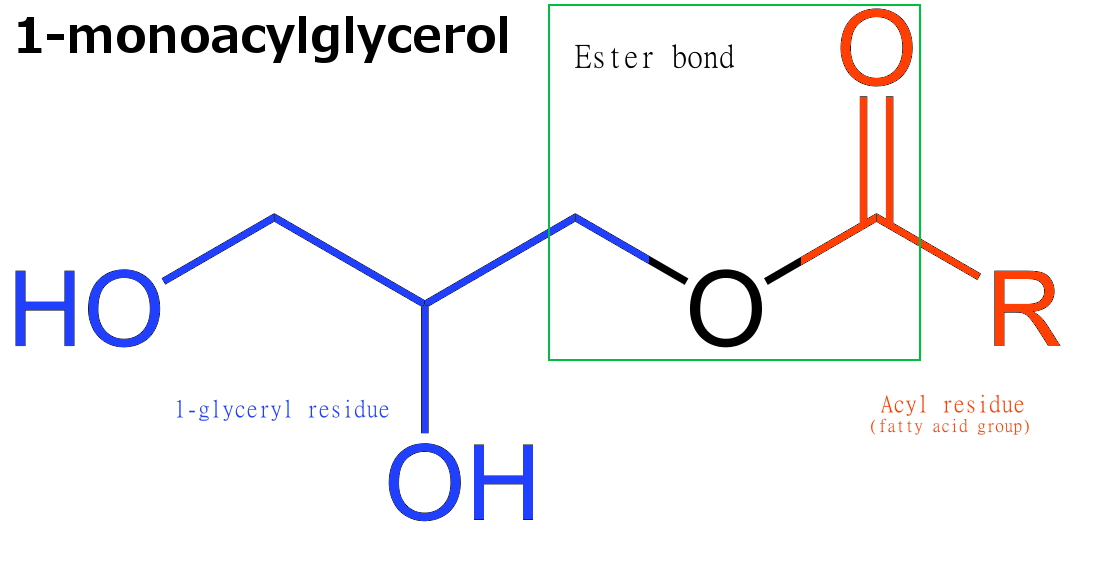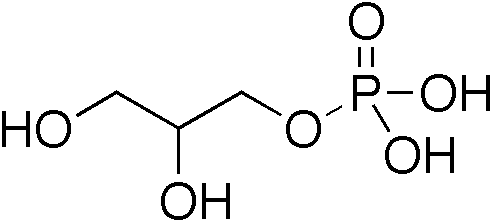|
Mono- And Diglycerides Of Fatty Acids
Mono- and diglycerides of fatty acids ( E471) refers to a naturally occurring class of food additive composed of diglycerides and monoglycerides which is used as an emulsifier. It is also used as a fruit coating agent. This mixture is also sometimes referred to as partial glycerides. Synthesis Monoglycerides and diglycerides are both naturally present in various seed oils, however their concentration is usually low and industrial production is primarily achieved by a glycerolysis reaction between triglycerides (fats/oils) and glycerol. The raw materials of this may be either vegetable or animal fats and oils. Concerns for vegan, vegetarian and religious diets E471 is mainly produced from vegetable oils (such as soybean), although animal fats are sometimes used and cannot be completely excluded as being present in the product. The fatty acids from each source are chemically identical. The Vegan Society, which discourages eating animal-based foods, flags E471 as potentially anima ... [...More Info...] [...Related Items...] OR: [Wikipedia] [Google] [Baidu] |
Monoglyceride Structural Formula V
Monoglycerides (also: acylglycerols or monoacylglycerols) are a class of glycerides which are composed of a molecule of glycerol linked to a fatty acid via an ester bond. As glycerol contains both primary and secondary alcohol groups two different types of monoglycerides may be formed; 1-monoacylglycerols where the fatty acid is attached to a primary alcohol, or a 2-monoacylglycerols where the fatty acid is attached to the secondary alcohol. Synthesis Monoglycerides are produced both biologically and industrially. They are naturally present at very low levels (0.1-0.2%) in some seed oils such as olive oil, rapeseed oil and cottonseed oil. They are biosynthesized by the enzymatic hydrolysis of triglycerides by lipoprotein lipase and the enzymatic hydrolysis of diglycerides by diacylglycerol lipase; or as an intermediate in the alkanoylation of glycerol to form fats. Several monoglycerides are pharmacologically active (e.g. 2-oleoylglycerol, 2-arachidonoylglycerol). Industrial pro ... [...More Info...] [...Related Items...] OR: [Wikipedia] [Google] [Baidu] |
Animal
Animals are multicellular, eukaryotic organisms in the Kingdom (biology), biological kingdom Animalia. With few exceptions, animals Heterotroph, consume organic material, Cellular respiration#Aerobic respiration, breathe oxygen, are Motility, able to move, can Sexual reproduction, reproduce sexually, and go through an ontogenetic stage in which their body consists of a hollow sphere of Cell (biology), cells, the blastula, during Embryogenesis, embryonic development. Over 1.5 million Extant taxon, living animal species have been Species description, described—of which around 1 million are Insecta, insects—but it has been estimated there are over 7 million animal species in total. Animals range in length from to . They have Ecology, complex interactions with each other and their environments, forming intricate food webs. The scientific study of animals is known as zoology. Most living animal species are in Bilateria, a clade whose members have a Symmetry in biology#Bilate ... [...More Info...] [...Related Items...] OR: [Wikipedia] [Google] [Baidu] |
Fatty Acid Esters
Fatty is a derogatory term for someone who is obese. It may refer also to: People * Mai Fatty, Gambian politician * Roscoe Arbuckle (1887–1933), American actor and comedian * Fatty Briody (1858–1903), American Major League Baseball player * Fatty D (April Fores), American pornographic actress * Bob Fothergill (1897–1938), American Major League Baseball outfielder * William Foulke (footballer) (1874–1916), English cricketer and footballer * Fatty George (1927–1982), Austrian jazz musician * Richard Lamb (1907–1974), Australian racing cyclist * Fatty Lawrence (1903–1976), college gridiron football player * W. T. McLain (1885–1938), college gridiron football player, lawyer, and politician * Charles H. Smith (American football), University of Michigan football player in 1893–1894 * Roland Taylor (1946–2017), retired American Basketball Association and National Basketball Association player * Paul Vautin (born 1959), Australian former rugby league footballer an ... [...More Info...] [...Related Items...] OR: [Wikipedia] [Google] [Baidu] |
Food Additives
Food additives are substances added to food to preserve flavor or enhance taste, appearance, or other sensory qualities. Some additives have been used for centuries as part of an effort to preserve food, for example vinegar (pickling), salt (salting), smoke (smoking), sugar (crystallization), etc. This allows for longer-lasting foods such as bacon, sweets or wines. With the advent of processed foods in the second half of the twentieth century, many additives have been introduced, of both natural and artificial origin. Food additives also include substances that may be introduced to food indirectly (called "indirect additives") in the manufacturing process, through packaging, or during storage or transport. Numbering To regulate these additives and inform consumers, each additive is assigned a unique number called an "E number", which is used in Europe for all approved additives. This numbering scheme has now been adopted and extended by the '' Codex Alimentarius'' Commission t ... [...More Info...] [...Related Items...] OR: [Wikipedia] [Google] [Baidu] |
Diglyceride
A diglyceride, or diacylglycerol (DAG), is a glyceride consisting of two fatty acid chains covalently bonded to a glycerol molecule through ester linkages. Two possible forms exist, 1,2-diacylglycerols and 1,3-diacylglycerols. DAGs can act as surfactants and are commonly used as emulsifiers in processed foods. DAG-enriched oil (particularly 1,3-DAG) has been investigated extensively as a fat substitute due to its ability to suppress the accumulation of body fat; with total annual sales of approximately USD 200 million in Japan since its introduction in the late 1990s till 2009. Production Diglycerides are a minor component of many seed oils and are normally present at ~1–6%; or in the case of cottonseed oil as much as 10%. Industrial production is primarily achieved by a glycerolysis reaction between triglycerides and glycerol. The raw materials for this may be either vegetable oils or animal fats. Food additive Diglycerides, generally in a mix with monoglycerides (E471), ... [...More Info...] [...Related Items...] OR: [Wikipedia] [Google] [Baidu] |
Monoglyceride
Monoglycerides (also: acylglycerols or monoacylglycerols) are a class of glycerides which are composed of a molecule of glycerol linked to a fatty acid via an ester bond. As glycerol contains both primary and secondary alcohol groups two different types of monoglycerides may be formed; 1-monoacylglycerols where the fatty acid is attached to a primary alcohol, or a 2-monoacylglycerols where the fatty acid is attached to the secondary alcohol. Synthesis Monoglycerides are produced both biologically and industrially. They are naturally present at very low levels (0.1-0.2%) in some seed oils such as olive oil, rapeseed oil and cottonseed oil. They are biosynthesized by the enzymatic hydrolysis of triglycerides by lipoprotein lipase and the enzymatic hydrolysis of diglycerides by diacylglycerol lipase; or as an intermediate in the alkanoylation of glycerol to form fats. Several monoglycerides are pharmacologically active (e.g. 2-oleoylglycerol, 2-arachidonoylglycerol). Industrial p ... [...More Info...] [...Related Items...] OR: [Wikipedia] [Google] [Baidu] |
Polyglycerol Polyricinoleate
Polyglycerol polyricinoleate (PGPR), E476, is an emulsifier made from glycerol and fatty acids (usually from castor bean, but also from soybean oil). In chocolate, compound chocolate and similar coatings, PGPR is mainly used with another substance like lecithin to reduce viscosity. It is used at low levels (below 0.5%), and works by decreasing the friction between the solid particles (e.g. cacao, sugar, milk) in molten chocolate, reducing the yield stress so that it flows more easily, approaching the behaviour of a Newtonian fluid. It can also be used as an emulsifier in spreads and in salad dressings, or to improve the texture of baked goods. It is made up of a short chain of glycerol molecules connected by ether bonds, with ricinoleic acid side chains connected by ester bonds. PGPR is a yellowish, viscous liquid, and is strongly lipophilic: it is soluble in fats and oils and insoluble in water and ethanol. Manufacture Glycerol is heated to above 200 °C in a reactor in ... [...More Info...] [...Related Items...] OR: [Wikipedia] [Google] [Baidu] |
Plastic Film
Plastic film is a thin continuous polymeric material. Thicker plastic material is often called a "sheet". These thin plastic membranes are used to separate areas or volumes, to hold items, to act as barriers, or as printable surfaces. Plastic films are used in a wide variety of applications. These include: packaging, plastic bags, labels, building construction, landscaping, electrical fabrication, photographic film, film stock for movies, video tape, etc. Materials Almost all plastics can be formed into a thin film. Some of the primary ones are: * Polyethylene – The most common plastic film is made of one of the varieties of polyethylene: low-density polyethylene, medium-density polyethylene, high-density polyethylene, or linear low-density polyethylene. * Polypropylene – Polypropylene can be made a cast film, biaxially oriented film (BOPP), or as a uniaxially oriented film. * Polyester – BoPET is a biaxially oriented polyester film. * Nylon – BOPA/BON is a ... [...More Info...] [...Related Items...] OR: [Wikipedia] [Google] [Baidu] |
South America
South America is a continent entirely in the Western Hemisphere and mostly in the Southern Hemisphere, with a relatively small portion in the Northern Hemisphere at the northern tip of the continent. It can also be described as the southern subregion of a single continent called America. South America is bordered on the west by the Pacific Ocean and on the north and east by the Atlantic Ocean; North America and the Caribbean Sea lie to the northwest. The continent generally includes twelve sovereign states: Argentina, Bolivia, Brazil, Chile, Colombia, Ecuador, Guyana, Paraguay, Peru, Suriname, Uruguay, and Venezuela; two dependent territories: the Falkland Islands and South Georgia and the South Sandwich Islands; and one internal territory: French Guiana. In addition, the ABC islands of the Kingdom of the Netherlands, Ascension Island (dependency of Saint Helena, Ascension and Tristan da Cunha, a British Overseas Territory), Bouvet Island ( dependency of Norway), Pa ... [...More Info...] [...Related Items...] OR: [Wikipedia] [Google] [Baidu] |
Apeel Sciences
Apeel Sciences is a company based in Goleta, California whose edible coating product Apeel can make avocados, citrus and other types of fruit last twice as long as usual by using a tasteless edible coating made from plant materials. The coating's formulation can be modified for strawberries, mangoes, apples, bananas, kumquats, citrus, and asparagus. Founding Apeel was founded in 2012 by James Rogers, after receiving a $100,000 grant from the Bill and Melinda Gates Foundation to help reduce post-harvest food waste in developing countries that lacked refrigeration infrastructure. After the initial grant, backing has been provided by Microsoft cofounder Bill Gates and venture capitalist firm Andreessen Horowitz. Apeel has raised $110 million in financing to date. See also *Edible packaging Edible packaging refers to packaging which is edible and biodegradable. Edible food packaging Several manufacturers are developing or producing food packaging that is edible. One example is ... [...More Info...] [...Related Items...] OR: [Wikipedia] [Google] [Baidu] |
The Vegan Society
The Vegan Society is a registered charity and the oldest vegan organization in the world, founded in the United Kingdom in 1944 by Donald Watson, Elsie Shrigley, George Henderson and his wife Fay Henderson among others. History In November, 1944 Donald Watson secretary of the Leicester Vegetarian Society who identified as a non-dairy vegetarian started a newsletter ''The Vegan News'', sub-titled "Quarterly Magazine of the Non-Dairy Vegetarians". Watson coined the term vegan to describe a vegetarian diet devoid of all animal-derived ingredients such as dairy and eggs. He derived the term from the word vegetarian by taking its first three letters and its last two letters because "veganism starts with vegetarianism and carries it through to its logical conclusion".Preece, Rod. (2008). ''Sins of the Flesh: A History of Ethical Vegetarian Thought''. UBC Press. pp. 298-299. However, Watson credited founding members G. A. Henderson and his wife Fay K. Henderson as originating the i ... [...More Info...] [...Related Items...] OR: [Wikipedia] [Google] [Baidu] |
Vegetable
Vegetables are parts of plants that are consumed by humans or other animals as food. The original meaning is still commonly used and is applied to plants collectively to refer to all edible plant matter, including the flowers, fruits, stems, leaves, roots, and seeds. An alternative definition of the term is applied somewhat arbitrarily, often by culinary and cultural tradition. It may exclude foods derived from some plants that are fruits, flowers, nuts, and cereal grains, but include savoury fruits such as tomatoes and courgettes, flowers such as broccoli, and seeds such as pulses. Originally, vegetables were collected from the wild by hunter-gatherers and entered cultivation in several parts of the world, probably during the period 10,000 BC to 7,000 BC, when a new agricultural way of life developed. At first, plants which grew locally would have been cultivated, but as time went on, trade brought exotic crops from elsewhere to add to domestic types. Nowadays, ... [...More Info...] [...Related Items...] OR: [Wikipedia] [Google] [Baidu] |








